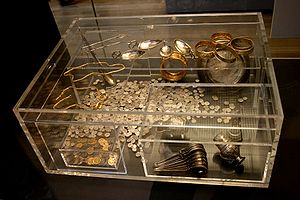
Back كنز هوكسن Arabic Tresor de Hoxne Catalan Hoxne-skatten Danish Depotfund von Hoxne German Tesoro de Hoxne Spanish Hoxne'i aardeleid Estonian گنجینه هاکسن Persian Trésor de Hoxne French Tesouro de Hoxne Galician Tesoro di Hoxne Italian
52°20′33″N 01°11′15″E / 52.34250°N 1.18750°E
| Hoxne Hoard | |
|---|---|
 Display case reconstructing the arrangement of the hoard treasure when excavated. | |
| Material | Gold, silver, bronze, iron, and organic material |
| Created | 4th or 5th century |
| Period/culture | Roman Empire |
| Discovered | Hoxne, Suffolk, 16 November 1992 |
| Present location | Room 49, British Museum, London[1] |
The Hoxne Hoard (/ˈhɒksən/ HOK-sən)[2] is the largest hoard of late Roman silver and gold discovered in Britain,[3] and the largest collection of gold and silver coins of the fourth and fifth centuries found anywhere within the former Roman Empire.[4] It was found by Eric Lawes, a metal detectorist in the village of Hoxne in Suffolk, England in 1992. The hoard consists of 14,865 Roman gold, silver, and bronze coins and approximately 200 items of silver tableware and gold jewellery.[5] The objects are now in the British Museum in London, where the most important pieces and a selection of the rest are on permanent display. In 1993, the Treasure Valuation Committee valued the hoard at £1.75 million (about £4.5 million in 2023).[6]
The hoard was buried in an oak box or small chest filled with items in precious metal, sorted mostly by type, with some in smaller wooden boxes and others in bags or wrapped in fabric. Remnants of the chest and fittings, such as hinges and locks, were recovered in the excavation. The coins of the hoard date it after AD 407, which coincides with the end of Britain as a Roman province.[7] The owners and reasons for burial of the hoard are unknown, but it was carefully packed and the contents appear consistent with what a single very wealthy family might have owned. It is likely that the hoard represents only a part of the wealth of its owner, given the lack of large silver serving vessels and of some of the most common types of jewellery.
The Hoxne Hoard contains several rare and important objects, such as a gold body-chain and silver-gilt pepper-pots (piperatoria), including the Empress pepper pot. The hoard is also of particular archaeological significance because it was excavated by professional archaeologists with the items largely undisturbed and intact. The find helped to improve the relationship between metal detectorists and archaeologists, and influenced a change in English law regarding finds of treasure.[8]
- ^ Cite error: The named reference
Johns 2010-p4was invoked but never defined (see the help page). - ^ "The Juliana Bracelet from the Hoxne hoard". British Museum. Archived from the original on 7 September 2010. Retrieved 19 June 2010.
- ^ Cite error: The named reference
histwas invoked but never defined (see the help page). - ^ Cite error: The named reference
JB166was invoked but never defined (see the help page). - ^ Cite error: The named reference
jb169was invoked but never defined (see the help page). - ^ Cite error: The named reference
independentwas invoked but never defined (see the help page). - ^ Birley 2005, p. 458
- ^ Johns & Bland 1994, p. 173
© MMXXIII Rich X Search. We shall prevail. All rights reserved. Rich X Search